| Alkyl (40% C12, 50% C14, 10% C16) dimethyl benzyl ammonium chloride | 17.06% |
| Didecyl dimethyl ammonium chloride | 7.80% |
| Glutaraldehyde | 10.725% |
-
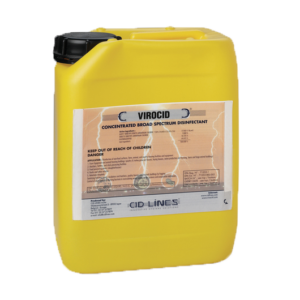 Virocid is a highly concentrated and broad spectrum disinfectant for use in food processing establishments, slaughter houses and livestock industries. Virocid is effective against: viruses, bacteria and fungi. Effective at rates as low as 0.25% (1:400). DIN 02239726 Active Ingredients
Virocid is a highly concentrated and broad spectrum disinfectant for use in food processing establishments, slaughter houses and livestock industries. Virocid is effective against: viruses, bacteria and fungi. Effective at rates as low as 0.25% (1:400). DIN 02239726 Active Ingredients -
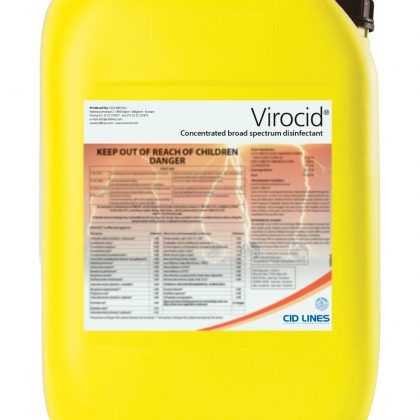 Virocid is a highly concentrated and broad spectrum disinfectant for use in food processing establishments, slaughter houses and livestock industries. Virocid is effective against: viruses, bacteria and fungi. Effective at rates as low as 0.25% (1:400). DIN 02239726 Active Ingredients
Virocid is a highly concentrated and broad spectrum disinfectant for use in food processing establishments, slaughter houses and livestock industries. Virocid is effective against: viruses, bacteria and fungi. Effective at rates as low as 0.25% (1:400). DIN 02239726 Active IngredientsAlkyl (40% C12, 50% C14, 10% C16) dimethyl benzyl ammonium chloride 17.06% Didecyl dimethyl ammonium chloride 7.80% Glutaraldehyde 10.725% Directions For Use
To disinfect hard non-porous surfaces (livestock equipment, floors, walls, table tops, counter tops), apply a 0.25% (1:400) solution to thoroughly wet surface. Spray the surface and let stand for 10 minutes. Virocid is a concentrate that can be used with a mop and bucket, trigger sprayers, sponge, or by soaking. Heavily soiled surfaces should be precleaned prior to disinfection. All food contact surfaces must be thoroughly rinsed with potable water after disinfection.Storage
Store in original container, in a dry, cool place. Do not store in food processing environments.Disposal
1. Rinse the emptied container thoroughly and add the rinsings to the treatment site. 2. Follow local instructions for any required additional cleaning of the container prior to disposal. 3. Make the empty container unsuitable for further use. 4. Disposal of product and packaging: The product and packaging must be disposed of in accordance with local requirements.Precautions
KEEP OUT OF REACH OF CHILDREN. Danger - Corrosive to eyes. Do not get in eyes, on skin or clothing. Use appropriate clothes, gloves and eye protection. Harmful if swallowed. Avoid contamination of food.First Aid
In case of contact, immediately flush eyes or skin with plenty of water for at least 15 minutes. For eyes, call a physician. Remove and wash contaminated clothing before reuse. If inhaled, breathe fresh air and consult a physician. If swallowed, do NOT induce vomiting. Call a physician or poison control centre immediately. MSDS -
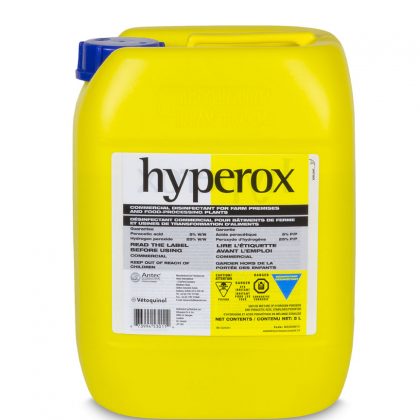 Hyperox consists of a blend of peracetic acid, hydrogen peroxide, acetic acid and surfactant in a long lasting stabilized aqueous solution. Hyperox has a broad spectrum biocidal activity and is non-tainting, does not leave residues after application and degrades to acetic acid, oxygen and water, each of which presents low environmental hazards. DIN 02240361 Active IngredientsPeracetic acid: 5% W/W Hydrogen peroxide: 25% W/W.
Hyperox consists of a blend of peracetic acid, hydrogen peroxide, acetic acid and surfactant in a long lasting stabilized aqueous solution. Hyperox has a broad spectrum biocidal activity and is non-tainting, does not leave residues after application and degrades to acetic acid, oxygen and water, each of which presents low environmental hazards. DIN 02240361 Active IngredientsPeracetic acid: 5% W/W Hydrogen peroxide: 25% W/W.Directions For Use
For best results, pre-clean all surfaces using a detergent before using Hyperox™. For routine disinfection of hard non-porous surfaces like floors, walls, concrete, plastic, stainless steel, glass, enameled surfaces, tile and any other hard non-porous surfaces which are not harmed by water: A 1:256 solution of Hyperox™ (1 part of Hyperox™ in 255 parts of water) is recommended for terminal disinfection. In farm premises: Remove all poultry, livestock and feeds from premises during disinfection. Remove all manure, litter and droppings from floors, walls, and surfaces of facilities occupied or traversed by poultry or livestock. Empty all troughs, racks, and other feeding and watering appliances. Using a pressure washer or mechanical sprayer, saturate surfaces with the solution at a rate of 300 mL per square meter (10 minute minimum contact time) and allow surfaces to dry before restocking. Ventilate building, coops and other closed spaces. All treated feed racks, mangers, troughs, automatic feeders, fountains, and waterers must be thoroughly rinsed with potable water prior to reuse. In food-processing plants: For food contact surfaces, rinse thoroughly with potable water after treatment with Hyperox™. For disinfection of equipment: A 1:128 solution of Hyperox™ (1 part of Hyperox™ in 127 parts of water) is recommended for cleaning and disinfecting equipment (such as buckets and utensils). Remove heavy soil from equipment to be treated. Allow disinfectant solution to remain in contact with the equipment for at least 10 minutes. Any milking equipment or equipment in contact with food where the product has been used should be flushed with potable water prior to reuse. For disinfection of foot and wheel dips: Foot and wheel dips disinfection can be made using a 1:128 solution of Hyperox™ (1 part of Hyperox™ in 127 parts of water). Boots and wheels should be immersed for at least one minute, so as to completely wet surfaces and allowed to air dry. Change foot or wheel dips’ solution when soiled or daily. For disinfection of water systems: A 1:256 solution of Hyperox™ (1 part of Hyperox™ in 255 parts of water) is recommended for water systems disinfection. Drain the system and fill with the solution for a 10 minute contact time. Drain and flush the water lines with potable water after disinfection. For disinfection by fogging: A 1:10 solution of Hyperox™ (1 part of Hyperox™ in 9 parts of water) is recommended for fogging. Use a thermal or mechanical fogging machine and apply at the rate of 17 mL per cubic meter. Leave for 30 minutes and vent for 30 minutes to 1 hour before re-entry.Storage
Store in the original container in a cool, well-ventilated dry room. Keep product away from sources of heat and combustible material. Avoid direct sunlight. Store away from food, feed or other pesticides. Containers must be stored upright only (do not block cap vent).Disposal
Do not reuse container. Follow provincial instructions for any additional cleaning of the container prior to its disposal. Make the empty container unsuitable for further use. Dispose of the container in accordance with provincial requirements. For information on the disposal of unused, unwanted product and the cleanup of spills, contact the provincial regulatory agency or the manufacturer.Precautions
KEEP OUT OF REACH OF CHILDREN: Oxidizing agent, corrosive to the eyes and skin. Do not inhale vapours given off by the product. Harmful or fatal if swallowed. Do not get in eyes, on skin, or on clothing. Wash hands, face and exposed skin before eating, drinking, or smoking, and after leaving the work area. Remove contaminated clothing and wash clothing before reuse. Avoid all contact by mouth, with skin or eyes. Accidental splashes on exposed skin or eyes should be washed off immediately with plenty of water. Wear suitable protective clothing (e.g. aprons, coveralls, complete footwear, etc.), chemical resistant gloves (e.g. nitrile or butyle rubber) and face protection (e.g. face shield, goggles, mask, etc.) when handling the concentrate and during application of product. When applying product by spraying or fogging, wear chemical resistant respirator. Do not remain in treated areas. Ensure proper ventilation after sealed areas have been treated. Do not contaminate food, feed or water troughs. Any treated surface or utensils that may contact food or feed products should be washed thoroughly with potable water after disinfection and before reuse. Do not return unused concentrate to the container in order to avoid possibility of contamination. TOXICOLOGICAL INFORMATION: Hyperox™ is an oxidizing agent and is corrosive and irritant. It can cause severe burns. Treat symptomatically. FIRST AID: Eye contact: If the product or its dilutions are splashed into the eye, rinse immediately with plenty of water or buffered eyewash. Remove any contact lenses. Seek medical advice immediately. Skin contact: Rinse any product off the skin immediately with water. Remove contaminated clothing and wash with water. Seek medical advice immediately. Ingestion: Allow patient to drink water if conscious, but do not induce vomiting. Rinse mouth out with water. Seek medical advice immediately. Inhalation: Remove affected person to fresh air. Keep upper body raised. Keep warm and in a stable position. Seek medical advice immediately. MSDS -
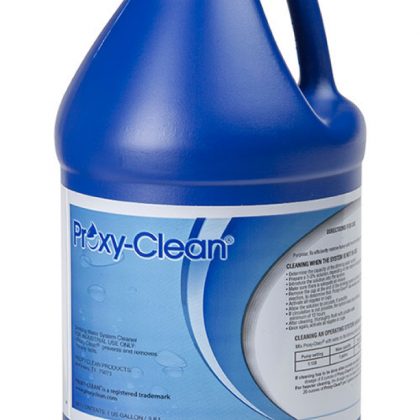 Proxy-Clean is a stabilized hydrogen peroxide based product specially formulated to remove and prevent heavy soils in livestock operations of any size. Proxy-Clean utilizes a proprietary stabilizer that is an active ingredient not found in any other product. The stabilizers used in other hydrogen peroxide products just allow them to be shelf stable. Proxy-Clean’s proprietary stabilizer acts as a decomposition catalyst allowing Proxy-Clean to do a complete cleaning on water lines and watering systems. Active IngredientsStabilized Hydrogen peroxide: 50% W/W.
Proxy-Clean is a stabilized hydrogen peroxide based product specially formulated to remove and prevent heavy soils in livestock operations of any size. Proxy-Clean utilizes a proprietary stabilizer that is an active ingredient not found in any other product. The stabilizers used in other hydrogen peroxide products just allow them to be shelf stable. Proxy-Clean’s proprietary stabilizer acts as a decomposition catalyst allowing Proxy-Clean to do a complete cleaning on water lines and watering systems. Active IngredientsStabilized Hydrogen peroxide: 50% W/W.Directions For Use
With Animals Present Mix Proxy-Clean with water to create the following stock solutions:
Discontinue use of any medication, chlorine or sanitizer when administering Proxy Clean. Resume the use of chlorine or other sanitizers after Proxy Clean treatment is finished. For routine sanitation use Proxy Clean at 25-50ppm in the drinking water (use test strips to measure concentration). Between 2 Lots/No Animals Present Fill the water lines with a Proxy Clean/water solution using the following options: Option 1: Use a 1:100 or 1:128 medicator to fill the water lines with a 1% or 0.78% solution of Proxy Clean. Allow the solution to remain in the water lines for a minimum of 48 hours before flushing. Option 2: Use a 3:100 medicator to fill the water lines with a 3% solution of Proxy Clean. Allow the solution to remain in the water lines for a minimum of 12 hours before flushing. When using Proxy Clean make sure that there is an adequate air release from your water system.Pump Water Proxy Clean Days 1 & 2 3 & 4 5 & 6 7-10 1:100 20L 250mL 350mL 475mL 600mL 1:128 20L 320mL 450mL 600mL 775mL Storage & Disposal
Please refer to MSDS sheet.Precautions & First Aid
Please refer to MSDS sheet. MSDS -
 Hombre mini blocks are an ideal choice as the foundation for biosecurity rodent control programs. Formulated with Difethialone, a single feed, second-generation anticoagulant. Mice, roof rats and Norway rats are readily attracted to Hombre mini blocks. Blocks are designed with a center hole for securing to prevent rodents from translocating rodenticide into sensitive areas. MSDS
Hombre mini blocks are an ideal choice as the foundation for biosecurity rodent control programs. Formulated with Difethialone, a single feed, second-generation anticoagulant. Mice, roof rats and Norway rats are readily attracted to Hombre mini blocks. Blocks are designed with a center hole for securing to prevent rodents from translocating rodenticide into sensitive areas. MSDS -
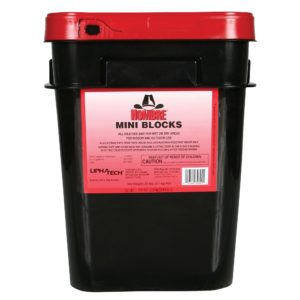 Hombre mini blocks are an ideal choice as the foundation for biosecurity rodent control programs. Formulated with Difethialone, a single feed, second-generation anticoagulant. Mice, roof rats and Norway rats are readily attracted to Hombre mini blocks. Blocks are designed with a center hole for securing to prevent rodents from translocating rodenticide into sensitive areas. MSDS
Hombre mini blocks are an ideal choice as the foundation for biosecurity rodent control programs. Formulated with Difethialone, a single feed, second-generation anticoagulant. Mice, roof rats and Norway rats are readily attracted to Hombre mini blocks. Blocks are designed with a center hole for securing to prevent rodents from translocating rodenticide into sensitive areas. MSDS -
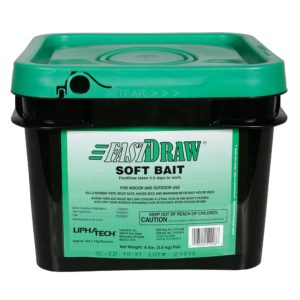 FastDraw® Soft Bait is a revolutionary concept in rodenticide technology from Liphatech. It contains the active ingredient Difethialone, food-grade grains and oils, and has a unique no wax formula. FastDraw® pouches combine the bait integrity of mini-blocks with the money-saving, targeted dosing, of place packs. It is effective even in areas of infestation where competing food sources exist.
FastDraw® Soft Bait is a revolutionary concept in rodenticide technology from Liphatech. It contains the active ingredient Difethialone, food-grade grains and oils, and has a unique no wax formula. FastDraw® pouches combine the bait integrity of mini-blocks with the money-saving, targeted dosing, of place packs. It is effective even in areas of infestation where competing food sources exist.- Powerful Attraction: unique no wax formula, for maximum attraction to get infestations under control.
- Convenient and Versatile: offers targeted dosing, with a 10-gram (0.35 oz.) easy-to-secure bait pouch, for challenging placements.
- Outstanding Results: contains the single-feed, second-generation anticoagulant active ingredient Difethialone formulated at 25PPM for superior palatability.
- For use only in indoor areas.
-
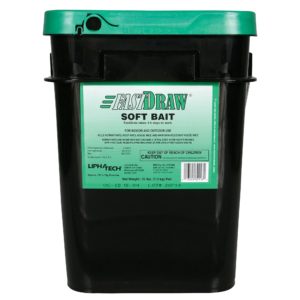 FastDraw® Soft Bait is a revolutionary concept in rodenticide technology from Liphatech. It contains the active ingredient Difethialone, food-grade grains and oils, and has a unique no wax formula. FastDraw® pouches combine the bait integrity of mini-blocks with the money-saving, targeted dosing, of place packs. It is effective even in areas of infestation where competing food sources exist.
FastDraw® Soft Bait is a revolutionary concept in rodenticide technology from Liphatech. It contains the active ingredient Difethialone, food-grade grains and oils, and has a unique no wax formula. FastDraw® pouches combine the bait integrity of mini-blocks with the money-saving, targeted dosing, of place packs. It is effective even in areas of infestation where competing food sources exist.- Powerful Attraction: unique no wax formula, for maximum attraction to get infestations under control.
- Convenient and Versatile: offers targeted dosing, with a 10-gram (0.35 oz.) easy-to-secure bait pouch, for challenging placements.
- Outstanding Results: contains the single-feed, second-generation anticoagulant active ingredient Difethialone formulated at 25PPM for superior palatability.
- For use only in indoor areas.
-
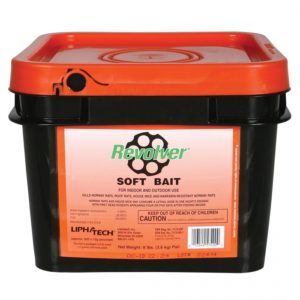 Revolver® soft bait provides a highly palatable formulation of the most widely used active ingredient, Bromadiolone. It is the solution when rotating to a Bromadiolone rodenticide in your biosecurity rodent control program. Revolver contains no wax, increasing palatability and results, in a low-cost per placement 12 gram (0.42 oz.) pouch. Food-grade oils and grains produce an aroma attracting rodents away from competing food sources, providing strong knock-down control of the toughest rodent populations. When compared to competitive green wax-blocks, Revolver no-wax soft bait outperforms and delivers increased palatability, with no bait melt in high temperatures, making it the superior Bromadiolone rodenticide in your bait rotation. No-wax soft bait pouches are easy to use and allow tailored dosing to control heavy rodent infestations or as a low cost per placement monitoring bait, saving producers money and bait waste. Revolver pouches can also be used like a conventional mini-block anchored in a bait station, or end-users can strategically place this unique presentation in tight, hard to reach places where mini-blocks will not fit, targeting where rodents live and reproduce. MSDS
Revolver® soft bait provides a highly palatable formulation of the most widely used active ingredient, Bromadiolone. It is the solution when rotating to a Bromadiolone rodenticide in your biosecurity rodent control program. Revolver contains no wax, increasing palatability and results, in a low-cost per placement 12 gram (0.42 oz.) pouch. Food-grade oils and grains produce an aroma attracting rodents away from competing food sources, providing strong knock-down control of the toughest rodent populations. When compared to competitive green wax-blocks, Revolver no-wax soft bait outperforms and delivers increased palatability, with no bait melt in high temperatures, making it the superior Bromadiolone rodenticide in your bait rotation. No-wax soft bait pouches are easy to use and allow tailored dosing to control heavy rodent infestations or as a low cost per placement monitoring bait, saving producers money and bait waste. Revolver pouches can also be used like a conventional mini-block anchored in a bait station, or end-users can strategically place this unique presentation in tight, hard to reach places where mini-blocks will not fit, targeting where rodents live and reproduce. MSDS -
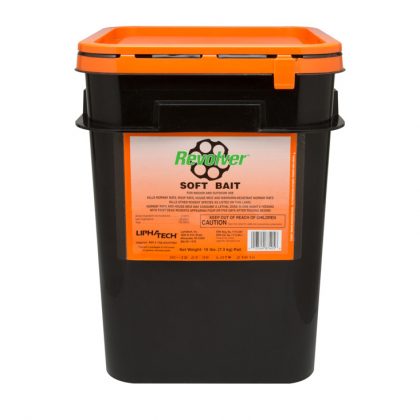 Revolver® soft bait provides a highly palatable formulation of the most widely used active ingredient, Bromadiolone. It is the solution when rotating to a Bromadiolone rodenticide in your biosecurity rodent control program. Revolver contains no wax, increasing palatability and results, in a low-cost per placement 12 gram (0.42 oz.) pouch. Food-grade oils and grains produce an aroma attracting rodents away from competing food sources, providing strong knock-down control of the toughest rodent populations. When compared to competitive green wax-blocks, Revolver no-wax soft bait outperforms and delivers increased palatability, with no bait melt in high temperatures, making it the superior Bromadiolone rodenticide in your bait rotation. No-wax soft bait pouches are easy to use and allow tailored dosing to control heavy rodent infestations or as a low cost per placement monitoring bait, saving producers money and bait waste. Revolver pouches can also be used like a conventional mini-block anchored in a bait station, or end-users can strategically place this unique presentation in tight, hard to reach places where mini-blocks will not fit, targeting where rodents live and reproduce. MSDS
Revolver® soft bait provides a highly palatable formulation of the most widely used active ingredient, Bromadiolone. It is the solution when rotating to a Bromadiolone rodenticide in your biosecurity rodent control program. Revolver contains no wax, increasing palatability and results, in a low-cost per placement 12 gram (0.42 oz.) pouch. Food-grade oils and grains produce an aroma attracting rodents away from competing food sources, providing strong knock-down control of the toughest rodent populations. When compared to competitive green wax-blocks, Revolver no-wax soft bait outperforms and delivers increased palatability, with no bait melt in high temperatures, making it the superior Bromadiolone rodenticide in your bait rotation. No-wax soft bait pouches are easy to use and allow tailored dosing to control heavy rodent infestations or as a low cost per placement monitoring bait, saving producers money and bait waste. Revolver pouches can also be used like a conventional mini-block anchored in a bait station, or end-users can strategically place this unique presentation in tight, hard to reach places where mini-blocks will not fit, targeting where rodents live and reproduce. MSDS -
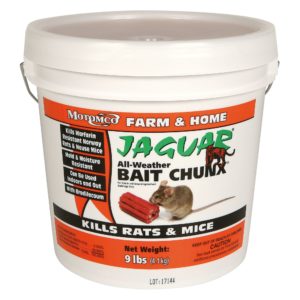 Jaguar All-Weather Bait Chunx contain the active ingredient Brodifacoum, Motomco's most powerful anticoagulant. Motomco's unique, proprietary extrusion process produces Bait Chunx with multiple edges that appeal to a rodent's desire to gnaw. Chunx are made with food-grade ingredients and small amounts of paraffin for a highly palatable bait. Jaguar Chunx are red in color and it's unique shape can be easily placed on rods in a bait station or secured using nails or wire. MSDS
Jaguar All-Weather Bait Chunx contain the active ingredient Brodifacoum, Motomco's most powerful anticoagulant. Motomco's unique, proprietary extrusion process produces Bait Chunx with multiple edges that appeal to a rodent's desire to gnaw. Chunx are made with food-grade ingredients and small amounts of paraffin for a highly palatable bait. Jaguar Chunx are red in color and it's unique shape can be easily placed on rods in a bait station or secured using nails or wire. MSDS -
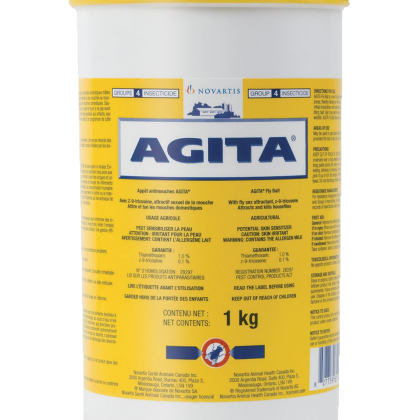 AGITA Fly Bait is a new fly bait formula containing a house fly sex attractant which encourages both male and female house flies to remain in the treated areas, thereby feeding on the bait. Bait should be scattered once per day over fly feeding areas and places where flies are known to congregate to provide initial knockdown and reduction of house fly populations. Scatter AGITA Fly Bait at a rate of 200 g per 100 m2 from a container or other device to avoid handling bait. Bait may also be used in hanging or stationary tamper-resistant bait boxes in locations not accessible to children, pets, domestic animals or wildlife. AGITA Fly Bait should be used as part of an integrated pest management program for house flies. AREAS OF USE: May be used in agricultural buildings (e.g. barns, poultry houses, etc.) in areas where house flies congregate such as windowsills and near animal pens, provided the bait is kept out of reach of animals. Do not use on walkways used by animals.
AGITA Fly Bait is a new fly bait formula containing a house fly sex attractant which encourages both male and female house flies to remain in the treated areas, thereby feeding on the bait. Bait should be scattered once per day over fly feeding areas and places where flies are known to congregate to provide initial knockdown and reduction of house fly populations. Scatter AGITA Fly Bait at a rate of 200 g per 100 m2 from a container or other device to avoid handling bait. Bait may also be used in hanging or stationary tamper-resistant bait boxes in locations not accessible to children, pets, domestic animals or wildlife. AGITA Fly Bait should be used as part of an integrated pest management program for house flies. AREAS OF USE: May be used in agricultural buildings (e.g. barns, poultry houses, etc.) in areas where house flies congregate such as windowsills and near animal pens, provided the bait is kept out of reach of animals. Do not use on walkways used by animals.Precautions
KEEP OUT OF REACH OF CHILDREN, PETS, DOMESTIC ANIMALS AND WILDLIFE. Do not ingest or inhale. Avoid contact with skin, eyes and clothing. Wear coveralls over a long-sleeved shirt and long pants, chemical-resistant gloves, shoes and socks when handling the product.Wear a NIOSH/MSHA-approved dust-filtering mask, long- sleeved shirt, long pants, shoes and socks during the clean up of product which is not completely consumed. Wash exposed body parts and change clothing after handling, and before eating, drinking or smoking. Do not contaminate feed, water, food or litter through application or disposal of product. Do not apply bait where animals can pick it up or lick the product. Prevent accidental transfer of the product, by people or animals, from treated areas to areas used by livestock. Harmful to bees. Do not discharge leftover product into ponds, streams or sewage systems. FIRST AID: If on skin or clothing: Take off contaminated clothing. Rinse skin immediately with plenty of water for 15-20 minutes. Call a poison control centre or doctor for treatment advice. If in eyes: Hold eye open and rinse slowly and gently with water for 15-20 minutes. Remove contact lenses, if present, after the first 5 minutes, then continue rinsing eye. Call a poison control centre or doctor for treatment advice. If swallowed: Call a poison control centre or doctor immediately for treatment advice. Have person sip a glass of water if able to swallow. Do not induce vomiting unless told to do so by a poison control centre or doctor. Do not give anything by mouth to an unconscious person. If inhaled: Move person to fresh air. If person is not breathing, call 911 or an ambulance, then give artificial respiration, preferably by mouth- to-mouth, if possible. Call a poison control centre or doctor for further treatment advice. Take container, label or product name and Pest Control Product Registration Number with you when seeking medical attention. TOXICOLOGICAL INFORMATION: No specific antidote is known. Apply symptomatic therapy. Induce emesis or lavage stomach. STORAGE AND DISPOSAL: Store in original, tightly closed containers. Protect from light and humidity. Do not contaminate water, food or feed by storage or disposal. Do not discharge leftover product into ponds, streams or sewage systems. Do not reuse empty container. Dispose of unused or spoiled bait in accordance with local requirements. Follow provincial instructions for any required cleaning of the container prior to its disposal. Make the empty container unsuitable for further use. Dispose of the container in accordance with provincial requirements. For information on disposal of unused, unwanted product, contact the manufacturer or the provincial regulatory agency. Contact the manufacturer and the provincial regulatory agency in case of a spill, and for the clean-up of spills. MSDS -
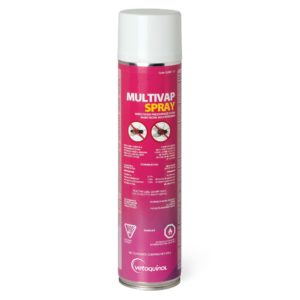 MSDSMultivap Spray Insecticide kills flies before they can breed. Controls house flies, stable flies and gnats.
MSDSMultivap Spray Insecticide kills flies before they can breed. Controls house flies, stable flies and gnats.DIRECTIONS
SPACE SPRAY > Kills flying insects in milking parlors, milkhouses and barns. Direct spray upwards to all parts of the room especially windows and other light sources. Apply at a rate of 1 to 2 seconds per 30 m3. Remove all animals from barn before using as a space spray. For best results, close all doors and windows during treatment. Ventilate treated areas thoroughly for at least 30 minutes before animal re-entry. Spray only when temperature is under 32°C. LIVESTOCK SPRAY > To treat beef and dairy cattle against attack of house flies, stable flies, and gnats. Spray animals once daily with a fine mist. Spray should be enough to wet ends of the hair only; do not wet the hair or skin. Take care not to spray in animal’s eyes. Treat dairy cattle at least 20 minutes before milking. Wash udders before milking. Do not use more often than once a day. PRECAUTIONS > KEEP OUT OF REACH OF CHILDREN > Do not remain in treated areas. Ensure proper ventilation after sealed areas have been treated. Do not spray over milk or milking equipment. Cover milk and milking utensils to prevent contamination from spray and dead insects. Any treated surface that may contact food or feed products should be washed thoroughly with potable water after spraying and before reuse. Do not contaminate food, feed or water troughs. Avoid inhalation of spray. Avoid contact with skin and eyes. Wash exposed skin after using. Product is toxic to fish. Do not contaminate any body of water. CONTENTS UNDER PRESSURE > Do not puncture or incinerate can. Do not store at temperatures above 50°C or in direct sunlight. Do not use in presence of open flame or sparks. FIRST AID > If in eyes > Hold eye open and rinse slowly and gently with water for 15-20 minutes. Remove contact lenses, if present, after the first 5 minutes, then continue rinsing eye. Call a poison control centre or doctor for treatment advice. If on skin or clothing > Take off contaminated clothing. Rinse skin immediately with plenty of water for 15-20 minutes. Call a poison control centre or doctor for treatment advice. If inhaled > Move person to fresh air. If person is not breathing, call 911 or an ambulance, then give artificial respiration, preferably by mouth-to-mouth, if possible. Call a poison control centre or doctor for further treatment advice. If swallowed > Call a poison control centre or doctor immediately for treatment advice. Do not induce vomiting unless told to do so by a poison control centre or doctor. Do not give any liquid to the person. Do not give anything by mouth to an unconscious person. Take container, label or product name and Pest Control Product Registration Number with you when seeking medical attention. TOXICOLOGICAL INFORMATION > Treat symptomatically. This product contains petroleum distillates. Vomiting can cause aspiration pneumonia. NOTICE TO USER > This pest control product is to be used only in accordance with the directions on the label. It is an offence under the Pest Control Products Act to use this product in a way that is inconsistent with the directions on the label. The user assumes the risk to persons or property that arises from any such use of this product. DISPOSAL > When container is empty, press valve to release all remaining pressure. Dispose of empty container in accordance with provincial requirements. For information on the disposal of unused, unwanted product, contact the manufacturer or the provincial regulatory agency. Contact the manufacturer and the provincial regulatory agency in case of a spill, and for clean-up of spills. -
 18 or more $44.99 each AGITA 10 WG is a new water dispersible residual insecticidal bait formulation for the control of house flies (Musca domestica) in agricultural buildings (e.g. barns, poultry houses, etc.). The novel combination of a neonicotinoid insecticide with both contact and stomach modes of action, with a house fly sex attractant and a bait, provides an effective fly bait formula which encourages both male and female house flies to remain in treated areas and consume or contact lethal doses of the product. This unique formulation affords the end user up to 6 weeks of residual activity when applied according to label directions. In addition, AGITA 10 WG kills litter beetles (Alphitobius diaperinus) on contact in broiler houses. AGITA 10 WG should be used as part of an integrated pest management program for insects. Directions for Use: General: Use any AGITA 10 WG suspension on the day of mixing, preferably immediately after preparation. Do not treat dirty, highly porous or newly whitewashed walls to prevent loss of long term efficacy. Do not apply on metal and glass surfaces to avoid excessive run-off. Treated surfaces may display a slight, discernible discolouration (white to beige film or powder) when dry, that permits applicators to identify treated surfaces and monitor the rate of bait consumption. Apply ONLY in locations not accessible to children, pets, domestic animals or wildlife, and ONLY on surfaces not routinely contacted by livestock or workers/bystanders. Protect from direct sunlight, water and rainfall. DO NOT contaminate irrigation or drinking water supplies or aquatic habitats by cleaning of equipment or disposal of wastes. AGITA 10 WG is a formulation suitable for application as a paint-on and/or spray-on insecticidal bait for house flies or a contact insecticide for litter beetles. The appropriate recommendations for use rates and individual methods for these applications are as follows: Paint-On for Adult Fly Control: Thoroughly mix the appropriate quantity of AGITA 10 WG to effectively treat the intended surface areas with a corresponding volume of lukewarm water to obtain a suspension with the consistency of a brushable paint. In general, a ratio of 125 grams of AGITA 10 WG per 100 mL of water produces a mixture of suitable consistency that effectively coats surfaces and provides adequate drying times. The freshly prepared suspension should be applied using a brush and, because of the highly attractive nature of the AGITA bait formulation, need only be applied to a small percentage of the available surface area of a building. For paint applications, a daily maximum quantity of 2.0 kg of AGITA 10 WG may be mixed and applied by one person. Because of the effective attractive nature of the AGITA formulation, the suspension need only be applied using a brush to a small percentage of the available surface area of a building. As a general guide, apply the suspension at a rate of approximately 20 “spots” (of about 10 x 30 cm each) per 100 m2 of ground surface, in areas where flies congregate, such as window sills, doors frames, warm wall areas and near animal pens, ensuring that the bait is kept out of reach of animals and away from surfaces frequented by humans and domestic pets. Stir occasionally during application. Do not use on walkways used by animals or on any surfaces that may be routinely contacted by workers or bystanders. Where insufficient surface area is available for painting or where some slight white discoloration caused by the “paint” is unacceptable, paint strips of cardboard, wood or light boards and hang them from the ceiling in locations not accessible to children, pets, domestic animals or wildlife. Spray-On for Adult Fly Control: For applications employing a low-pressure spray applicator, thoroughly mix the Fly Bait with lukewarm water at the ratio of 125 grams of AGITA 10 WG per 1000 mL of water to obtain a mixture of suitable consistency that will effectively coat surfaces while providing adequate drying times. Apply suspension using a standard course spray applicator to appropriate target locations of the wall/ceiling surface area. Again, because the effective attractive nature of the AGITA bait formulation, and unlike “traditional” agricultural fly wall sprays, the suspension need only be applied to a small percentage of the surface area of a building to provide effective fly control. The amount of diluted product required to treat a particular building will vary depending upon the nature of surface to be treated. Apply spray to the point of run-off, while avoiding excessive run-off, to areas where flies congregate, such as window sills/frames, door frames, warm wall areas and near animal pens, ensuring that the bait is kept out of reach of animals and away from surfaces frequented by humans and domestic pets. Stir occasionally during application. Do not use on walkways used by animals or on any surfaces that may be routinely contacted by workers or bystanders. Where insufficient surface area is available for bait application or where some slight discoloration caused by the spray is unacceptable, spray strips of cardboard, wood or light boards and hang them from the ceiling in locations not accessible to children, pets, domestic animals or wildlife. AGITA 10 WG may provide up to six weeks of residual activity, depending upon the size of the resident pest population, re-infestation or re-invasion from neighbouring farms, etc. Estimation of the amount of bait remaining can be determined by observation of the rate at which the slight discolouration of treated surfaces (slight whitish/beige “powder”) disappears. Re-apply the product, as necessary, so as to reduce the possibility of a resident fly population being re-established. The ultimate residual control afforded by AGITA 10 WG will depend upon the size and source of the resident fly population, the re-invasion rates from neighbouring agricultural practices, and the on-farm maintenance, sanitation and hygiene procedures and schedules (e.g. routine removal of fly breeding sites/material, etc.). It is always recommended that AGITA Fly Bait products be used as part of a complete integrated pest management program designed to minimize pest populations and optimize the housing conditions for economic animals. Directions for use against Litter Beetle in Broiler Houses (“Band Spray” Method): AGITA 10 WG kills litter beetles (Alphitobius diaperinus) by direct contact. Using the preparation methods detailed above, AGITA 10 WG should be applied as a suspension in a single 1m wide band at the rate of 4 grams per square metre of surface area (i.e. “band spray method” - ~ 2 to 3 X the house fly control rate). Ensure that the product is mixed with sufficient water to allow a thorough wetting of this 1m wide band on all sides of the broiler house (~1 L per 15 m2). The spray should be applied after cleaning of the facility and the placement of new litter, but just before the house is heated for the arrival of a new batch of chicks. The spray should be applied to the litter beetles’ primary migration routes towards the new litter. The area around any cracks or openings in the ceiling or walls should also be sprayed. The rationale for this program is the fact that the beetles hide in the ceiling or walls between cycles and then crawl out just before the new chicks arrive. At this point, therefore, they will come into contact with the spray band.
18 or more $44.99 each AGITA 10 WG is a new water dispersible residual insecticidal bait formulation for the control of house flies (Musca domestica) in agricultural buildings (e.g. barns, poultry houses, etc.). The novel combination of a neonicotinoid insecticide with both contact and stomach modes of action, with a house fly sex attractant and a bait, provides an effective fly bait formula which encourages both male and female house flies to remain in treated areas and consume or contact lethal doses of the product. This unique formulation affords the end user up to 6 weeks of residual activity when applied according to label directions. In addition, AGITA 10 WG kills litter beetles (Alphitobius diaperinus) on contact in broiler houses. AGITA 10 WG should be used as part of an integrated pest management program for insects. Directions for Use: General: Use any AGITA 10 WG suspension on the day of mixing, preferably immediately after preparation. Do not treat dirty, highly porous or newly whitewashed walls to prevent loss of long term efficacy. Do not apply on metal and glass surfaces to avoid excessive run-off. Treated surfaces may display a slight, discernible discolouration (white to beige film or powder) when dry, that permits applicators to identify treated surfaces and monitor the rate of bait consumption. Apply ONLY in locations not accessible to children, pets, domestic animals or wildlife, and ONLY on surfaces not routinely contacted by livestock or workers/bystanders. Protect from direct sunlight, water and rainfall. DO NOT contaminate irrigation or drinking water supplies or aquatic habitats by cleaning of equipment or disposal of wastes. AGITA 10 WG is a formulation suitable for application as a paint-on and/or spray-on insecticidal bait for house flies or a contact insecticide for litter beetles. The appropriate recommendations for use rates and individual methods for these applications are as follows: Paint-On for Adult Fly Control: Thoroughly mix the appropriate quantity of AGITA 10 WG to effectively treat the intended surface areas with a corresponding volume of lukewarm water to obtain a suspension with the consistency of a brushable paint. In general, a ratio of 125 grams of AGITA 10 WG per 100 mL of water produces a mixture of suitable consistency that effectively coats surfaces and provides adequate drying times. The freshly prepared suspension should be applied using a brush and, because of the highly attractive nature of the AGITA bait formulation, need only be applied to a small percentage of the available surface area of a building. For paint applications, a daily maximum quantity of 2.0 kg of AGITA 10 WG may be mixed and applied by one person. Because of the effective attractive nature of the AGITA formulation, the suspension need only be applied using a brush to a small percentage of the available surface area of a building. As a general guide, apply the suspension at a rate of approximately 20 “spots” (of about 10 x 30 cm each) per 100 m2 of ground surface, in areas where flies congregate, such as window sills, doors frames, warm wall areas and near animal pens, ensuring that the bait is kept out of reach of animals and away from surfaces frequented by humans and domestic pets. Stir occasionally during application. Do not use on walkways used by animals or on any surfaces that may be routinely contacted by workers or bystanders. Where insufficient surface area is available for painting or where some slight white discoloration caused by the “paint” is unacceptable, paint strips of cardboard, wood or light boards and hang them from the ceiling in locations not accessible to children, pets, domestic animals or wildlife. Spray-On for Adult Fly Control: For applications employing a low-pressure spray applicator, thoroughly mix the Fly Bait with lukewarm water at the ratio of 125 grams of AGITA 10 WG per 1000 mL of water to obtain a mixture of suitable consistency that will effectively coat surfaces while providing adequate drying times. Apply suspension using a standard course spray applicator to appropriate target locations of the wall/ceiling surface area. Again, because the effective attractive nature of the AGITA bait formulation, and unlike “traditional” agricultural fly wall sprays, the suspension need only be applied to a small percentage of the surface area of a building to provide effective fly control. The amount of diluted product required to treat a particular building will vary depending upon the nature of surface to be treated. Apply spray to the point of run-off, while avoiding excessive run-off, to areas where flies congregate, such as window sills/frames, door frames, warm wall areas and near animal pens, ensuring that the bait is kept out of reach of animals and away from surfaces frequented by humans and domestic pets. Stir occasionally during application. Do not use on walkways used by animals or on any surfaces that may be routinely contacted by workers or bystanders. Where insufficient surface area is available for bait application or where some slight discoloration caused by the spray is unacceptable, spray strips of cardboard, wood or light boards and hang them from the ceiling in locations not accessible to children, pets, domestic animals or wildlife. AGITA 10 WG may provide up to six weeks of residual activity, depending upon the size of the resident pest population, re-infestation or re-invasion from neighbouring farms, etc. Estimation of the amount of bait remaining can be determined by observation of the rate at which the slight discolouration of treated surfaces (slight whitish/beige “powder”) disappears. Re-apply the product, as necessary, so as to reduce the possibility of a resident fly population being re-established. The ultimate residual control afforded by AGITA 10 WG will depend upon the size and source of the resident fly population, the re-invasion rates from neighbouring agricultural practices, and the on-farm maintenance, sanitation and hygiene procedures and schedules (e.g. routine removal of fly breeding sites/material, etc.). It is always recommended that AGITA Fly Bait products be used as part of a complete integrated pest management program designed to minimize pest populations and optimize the housing conditions for economic animals. Directions for use against Litter Beetle in Broiler Houses (“Band Spray” Method): AGITA 10 WG kills litter beetles (Alphitobius diaperinus) by direct contact. Using the preparation methods detailed above, AGITA 10 WG should be applied as a suspension in a single 1m wide band at the rate of 4 grams per square metre of surface area (i.e. “band spray method” - ~ 2 to 3 X the house fly control rate). Ensure that the product is mixed with sufficient water to allow a thorough wetting of this 1m wide band on all sides of the broiler house (~1 L per 15 m2). The spray should be applied after cleaning of the facility and the placement of new litter, but just before the house is heated for the arrival of a new batch of chicks. The spray should be applied to the litter beetles’ primary migration routes towards the new litter. The area around any cracks or openings in the ceiling or walls should also be sprayed. The rationale for this program is the fact that the beetles hide in the ceiling or walls between cycles and then crawl out just before the new chicks arrive. At this point, therefore, they will come into contact with the spray band.Precautions
KEEP OUT OF REACH OF CHILDREN, PETS, DOMESTIC ANIMALS AND WILDLIFE. Avoid contact with skin, eyes and clothing. Avoid breathing spray mist. Wear coveralls over a long sleeved shirt and long pants, chemical-resistant gloves, shoes and socks when handling the product, clean-up and repair. Wear a NIOSH/MSHA-approved respirator when applying and a NIOSH/MSHA-approved dust-filtering mask during clean-up of the product that is not completely consumed. Wash exposed body parts and change clothing after handling, and before eating, drinking or smoking. Do not contaminate feed, water, food or litter through application or disposal of product. Do not apply bait where animals can lick the product. Prevent accidental transfer of the product, by people or animals, from treated areas to areas used by livestock. FIRST AID: IF SWALLOWED: Call a poison control centre or doctor immediately for treatment advice. Do not induce vomiting unless told to do so by a poison control centre or doctor. Do not give any liquid to the person. Do not give anything by mouth to an unconscious person. IF ON SKIN OR CLOTHING: Take off contaminated clothing. Rinse skin immediately with plenty of water for 15-20 minutes. Call a poison control centre or doctor for treatment advice. IF INHALED: Move person to fresh air. If person is not breathing, call 911 or an ambulance, then give artificial respiration, preferably by mouth-to-mouth, if possible. Call a poison control centre or doctor for further treatment advice. IF IN EYES: Hold eye open and rinse slowly and gently with water for 15-20 minutes. Remove contact lenses, if present, after the first 5 minutes, then continue rinsing eye. Call a poison control centre or doctor for treatment advice. Take container, label or product name and Pest Control Product Registration Number with you when seeking medical attention. TOXICOLOGICAL INFORMATION: There is no specific antidote for this product if ingested. If a large amount has been ingested and emesis is inadequate, lavage stomach. Treat symptomatically. ENVIRONMENTAL HAZARD: Toxic to bees. RESISTANCE MANAGEMENT: For resistance management, thiamethoxam is a Group 4 insecticide. Any house fly population may contain individuals naturally resistant to thiamethoxam and Group 4 insecticides. To delay insecticide resistance, avoid exclusive, repeated use of AGITA Fly Bait or other Group 4 insecticides. Keep accurate records of insecticides used in your operation. Keep the house fly population as low as possible by manure management.Storage
Store product in original, tightly sealed container. Store in a cool, dry place. Do not contaminate water, food or feed by storage or disposal. Do not reuse empty container.Disposal
1. Triple-or-pressure-rinse the empty container. Add the rinsings to the spray mixture in the tank. 2. Follow provincial instruction for any required additional cleaning of the container prior to its disposal. 3. Make the empty container unsuitable for further use. 4. Dispose of the container in accordance with provincial requirements. 5. For information on disposal of unused, unwanted product, contact the manufacturer or the provincial regulatory agency. Contact the manufacturer and the provincial regulatory agency in case of a spill, and for clean-up of spills. MSDS -
 For control of the lesser mealworm (the darkling beetles Alphitobius diaperinus) and other listed pests ACTIVE INGREDIENT: Tetrachlorvinphos - 50% w/w In case of spills, poisoning or fire, call your provincial emergency response line.
For control of the lesser mealworm (the darkling beetles Alphitobius diaperinus) and other listed pests ACTIVE INGREDIENT: Tetrachlorvinphos - 50% w/w In case of spills, poisoning or fire, call your provincial emergency response line.DIRECTIONS FOR USE
Use Debantic 50WP as part of an overall integrated pest management (IPM) program. Debantic 50WP Insecticide Poultry and Livestock Premise Spray is suitable for use in conventional power or low pressure knapsack sprayers. Agitation is recommended to prevent undue settling of the suspension. Follow the USE DIRECTIONS for the proper percent solution needed for a specific insect and areas or types of wall surfaces. Refer to DILUTION TABLE for the quantity of insecticide needed to make the percent solution recommended. PREMISES USE DIRECTIONSPOULTRY USE DIRECTIONS (DO NOT APPLY TO RESIDENCES)INSECT PROBLEM AREAS % SOLUTION REMARKS Flies Dairy barns, poultry houses, swine barns, other animal buildings. 2.0% For dry whitewashed wood or concrete block surfaces, apply 8 litres of solution/100 sq. m. 1.0% For unpainted wood or painted concrete block surfaces, apply 8 litres of solution/100 sq. m. 1.0% For masonite or galvanized sheet metal surfaces, apply 4 litres of solution/100 sq. m. Maggots Poultry droppings, manure piles, garbage piles, under feed troughs 1.0% Apply 4 litres of solution/10 sq. m. Penetrate problem area first time - repeat every 7-10 days thereafter. DILUTION TABLEINSECT TYPE OF HOUSING % SOLUTION REMARKS Lice & Mites Wire Cages 0.5% Apply directly to birds (4 litres/100 birds). Spray vent and fluff areas from below. Repeat when necessary. Do not repeat more often than every 14 days. For individual bird treatment, apply 30 mL of the mixture per bird. NOTE: For maximum lasting control of the northern fowl mite, penetration of the feathers around the vent area is essential. Use power sprayer at 7-9 kg/sq cm at no less than recommended pressure. More attention must be given to each individual bird when using low-pressure equipment. Treat roosters carefully and thoroughly to avoid re-infestation in breeding flocks. Floor Management Dust Box 50% WP Mix evenly throughout top layer of box contents using 150 g/100 birds. Lice, Mite & Larvae and adults of the lesser mealworm (the darkling beetle, Alphitobius diaperinus) Floor Management Roost Paint 1.0% Treat with brush or spray thoroughly, particularly cracks and crevices using 145-165 mL/10 m. Floor Management Litter 1.0% Apply 1-4 litres/100 sq. m. evenly for penetration to litter surface. Also apply thoroughly to walls, roost, cracks, crevices and interiors. Spray birds lightly. Floor Management Litter 50% WP Treat evenly and thoroughly using 75 g/10 sq. m. Use a rotary or mechanical duster. (Wear dust mask during this operation). Fowl Tick All Types 1.0% Apply 3-4 litres/10 sq. m. thoroughly to walls, ceilings, floor cracks and crevices with a power sprayer. PRECAUTIONS KEEP OUT OF REACH OF CHILDREN AND LIVESTOCK. Harmful if swallowed or absorbed through skin. Avoid breathing spray mist and dust. Do not get in eyes, on skin, or on clothing. Wash thoroughly with soap and water after handling and before eating or smoking. Avoid contamination of feed and foodstuffs. Store apart from food and feed in a cool place. This product is toxic to fish. Do not contaminate water by disposal of this product. Do not re-use empty container. FIRST AID IF SWALLOWED: Call a poison control centre or doctor immediately for treatment advice. Have person sip a glass of water if able to swallow. Do not induce vomiting unless told to do so by a poison control centre or doctor. Do not give anything by mouth to an unconscious person. IF INHALED: Move person to fresh air. If person is not breathing, call 911 or an ambulance, then give artificial respiration, preferably by mouth-to-mouth, if possible. Call a poison control centre or doctor for further treatment advice. IF ON SKIN OR CLOTHING: Take off contaminated clothing. Rinse skin immediately with plenty of water for 15-20 minutes. Call a poison control centre or doctor for treatment advice. IF IN EYES: Hold eye open and rinse slowly and gently with water for 15-20 minutes. Remove contact lenses if present, after the first 5 minutes, then continue rinsing eye. Call a poison control centre or doctor for treatment advice. Take container, label or product name and Pest Control Product Registration Number with you when seeking medical attention. TOXICOLOGICAL INFORMATION Tetrachlorvinphos is a cholinesterase inhibitor. Typical symptoms of overexposure to cholinesterase inhibitors include headache, nausea, dizziness, sweating, salivation, runny nose and eyes. This may progress to muscle twitching, weakness, tremor, incoordination, vomiting, abdominal cramps and diarrhea in more serious poisonings. A life-threatening poisoning is signified by loss of consciousness, incontinence, convulsions and respiratory depression with a secondary cardiovascular component. Treat symptomatically. If exposed, plasma and red blood cell cholinesterase tests may indicate degree of exposure (baseline data are useful). Atropine, only by injection, is the preferable antidote. Oximes, such as Pralidoxime Chloride, may be therapeutic if used early; however, use only in conjunction with atropine. In cases of severe acute poisoning, use antidotes immediately after establishing an open airway and respiration. With oral exposure, the decision of whether to induce vomiting or not should be made by an attending physician. DISPOSAL 1. Triple-or pressure-rinse the empty container. Add the rinsings to the spray mixture in the tank. 2. Follow provincial instruction for any required additional cleaning of the container prior to its disposal. 3. Make the empty container unsuitable for further use. 4. Dispose of the container in accordance with provincial requirements. 5. For information on disposal of unused, unwanted product, contact the manufacturer or the provincial regulatory agency. Contact the manufacturer and the provincial regulatory agency in case of a spill and for clean-up of spills. MSDSAMOUNT (kg) OF 50% WETTABLE POWDER AMOUNT OF WATER 0.5% SOLUTION 1% SOLUTION 2% SOLUTION 1/4 kg 25 litres 12 1/2 litres 6 1/4 litres 1 100 litres 50 litres 25 litres 2 200 litres 100 litres 50 litres 4 400 litres 200 litres 100 litres -
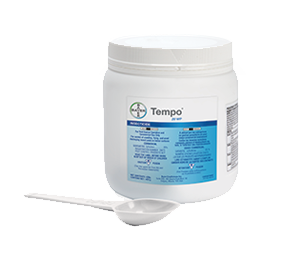 For control of crawling, flying, and wood destroying insect pests on indoor surfacesMSDS
For control of crawling, flying, and wood destroying insect pests on indoor surfacesMSDSGUARANTEE: Cyfluthrin 20% Directions For Use:
Read these entire Directions for Use before using Tempo 20 WP Insecticide. Do not formulate this product into other end-use products.General Information
Tempo 20 WP Insecticide contains 20% active ingredient, which will provide effective knockdown and residual control of the pests listed on the label. One level Tempo scoop or 4 level teaspoons contain 9.5 grams of Tempo 20 WP Insecticide. Do not use scoop or teaspoon for feed, food, or drinking water purposes. Tempo 20 WP Insecticide is intended for use as an indoor spot, or crack and crevice application in Dwellings, such as apartments, hospitals, hotels, houses and nursing homes; Institutions, such as factories, laboratories, mausoleums, non-commercial greenhouses, schools, stores and warehouses; Modes of transport, such as aircraft, buses, rail cars, ships and trucks; Food/feed establishments, such as bakeries, bottling plants, canneries, dairies, frozen food plants, grain mills, kitchens, meat packing plants, poultry and egg processing plants and restaurants; and Pet kennels. Tempo 20 WP Insecticide also is intended for use as a general surface spray for control of flying and crawling insects in livestock housing structures, including poultry houses. Tempo 20 WP Insecticide is intended to be mixed with water and applied with hand pressurized or power operated sprayers. Spray pressure should not exceed 345 KPa (50 psi) at the nozzle tip when used indoors. Add the appropriate amount of product when filling sprayer tank with water, shake or agitate as necessary to mix. Diluted spray mixture can be stored overnight and applied the following day, but the mixture should be agitated before spraying to prevent uneven distribution of product. Before leaving spray mixture unagitated for an extended period of time, release tank pressure and elevate nozzle and hose above tank outlet, activate trigger and drain all suspension from hose back into spray tank. Re-tighten spray tank lid and do not re-pressurize until starting to spray again. Tempo 20 WP Insecticide will not stain or cause damage to any painted or varnished household surface, plastic, fabric or other surface where water applied alone causes no damage.Spot, Crack And Crevice Applications
Mix one level Tempo scoop of Tempo 20 WP Insecticide in 3.75L of water to make a 0.05% active ingredient suspension. Under conditions of severe pest infestation or when longer residual control is needed, mix two level Tempo scoops of Tempo 20 WP Insecticide in 3.75L of water to make a 0.1% active ingredient suspension. Use a low pressure system with a pin-point or variable pattern nozzle to apply the suspension in specific areas such as cracks and crevices in or behind baseboards, in floors, walls, expansion joints, areas around water and sewer pipes, wall voids, or voids in table legs and equipment where pests can hide. Tempo 20 WP Insecticide can be reapplied at 10-day intervals, if necessary. Do not apply where electrical short circuits could occur. Use a dust or dry bait in these areas. Spot treatment with a low pressure coarse spray may be made ONLY to localized areas along baseboards; beneath and behind sinks, stoves, refrigerators and cabinets; around plumbing and other utility installations; around doors and windows. A spot is an area no larger than 0.2m2. NOTE: CARE SHOULD BE TAKEN TO AVOID DEPOSITING THE PRODUCT ONTO SURFACES WHICH ARE EASILY ACCESSIBLE BY CHILDREN.Food/feed Establishments:
Tempo 20 WP Insecticide applications are permitted in both food and non-food areas of food/feed handling establishments as a spot, or crack and crevice treatment. Food/feed establishments are defined as places other than private residences in which exposed food or feed is held, processed, prepared or served. Included also are areas for receiving, storing, packing (canning, bottling, wrapping, boxing), preparing, edible waste storage and enclosed processing systems (mills, dairies, edible oils, syrups) for food or feed. Serving areas where food is exposed and the facility is in operation are also considered food areas. Application in food handling areas of the facility may be made during close-down periods only. Do not apply directly to food or food-handling surfaces. Cover or remove all food processing and/or handling equipment before application. After application in food processing plants, bakeries, cafeterias and similar facilities, wash all equipment, benches, shelving and other surfaces which food will contact. Clean food handling or processing equipment and thoroughly rinse with clean, fresh water. Dwellings, Institutions and Modes of Transport: For general household pests and occasional invaders make applications in a manner as previously described under Spot, Crack and Crevice Application. Particular attention should be given to treating entry points and harbourage areas. Remove or tightly cover fish tanks and disconnect aerators during application. Bystanders and animals must be excluded during applications of Tempo 20 WP Insecticide, and not allowed to re-enter treated areas until at least two hours afterwards. For pantry pest control of exposed adult and immature stages of insects, make application to cupboards, shelving and storage areas. Particular attention should be given to treating cracks and crevices. Remove all utensils, uncovered foodstuffs (or any with package opened), shelf paper and other objects before spraying. Allow treated surfaces to dry and cover shelves with clean paper before replacing any utensils, foodstuff or other items. Any foodstuff accidentally contaminated with spray solution should be discarded. For stored product pest control of exposed adult and immature stages of insect pests, apply to cracks, crevices, and other surfaces where the pests have been seen or have harbourage. Treat warehouses, production facilities, storage areas, rail cars, truck beds and other areas where products are stored before filling with the product. Tempo 20 WP Insecticide may be used by pest control operators and grain producers to treat grain storage facilities and other areas noted above for stored product pest control. Cleaning of all areas prior to use of Tempo 20 WP Insecticide will increase levels of control. Any foodstuffs infested with pests should be removed and destroyed. For premises pest control make spot application in closets and storage areas where these pests normally feed or hide. Follow all precautions listed above for general household pests. For control of carpet beetles, apply as a spot treatment along baseboards and edges of carpeting, under carpets and rugs, in closets and on shelving. For control of flying insects indoors, apply as a spot treatment on window frames. Do not apply as a “space spray”. For control of carpenter ants in houses and other structures, use a 0.1% suspension and apply as a spot, crack and crevice or wall void application. Repeat treatments when necessary. Apply around doors and windows. Spray into cracks and crevices or through small drilled holes into voids where these ants or their nests are present. Do not exceed 30 to 50 mL of dilute suspension per m2 of treated surface. For aircraft pest control apply to cracks, crevices and other surfaces where the pests have been seen or have harbourage. Applications should not be made when passengers or non-essential personnel are present in the immediate or treated area. Passengers or other personnel should not be allowed to enter treated areas until at least two hours after application. Do not use in aircraft cabins. Do not allow spray to contact electrical and electronic systems. Pet Kennels: For use in pet kennels to control flying and crawling insects: apply as a spot or crack and crevice spray. Control will be enhanced when facilities are cleaned. Do not make applications of Tempo 20 WP Insecticide when animals are present in area of facility to be treated. Allow at least two hours after application before re-stocking treated area of the facility. Cover or remove animal feedstuffs or watering equipment.General Surface Applications
Livestock Housing (including Poultry Houses):
For use by pest control operators and livestock producers in livestock housing structures (including poultry houses) to control crawling and flying insect pests. For control of flies apply as a general surface spray using 1 or 2 level scoops of Tempo 20 WP Insecticide per 100 m2 in sufficient water to adequately cover the area being treated, but which will not allow dripping or run-off to occur. Use the higher rate when infestation is severe or when longer residual control is needed. Use a low pressure spray system with a fan-type nozzle to uniformly apply the suspension. Control will be enhanced if facilities are cleaned. Applications can be made to all fly resting surfaces such as walls, ceilings, posts, rafters, windows, dividers, stanchions, gates, bunks, curtains, etc. Full protective clothing is recommended, including a hat (preferably safety helmet with visor), safety glasses, goggles or face shield, respirator, long-sleeved coveralls, unlined rubber gloves and rubber boots. Do not apply Tempo 20 WP Insecticide when animals are present in area of facility to be treated. Apply only in well ventilated areas. Do not allow cattle to re-enter facilities within 2 hours following application and poultry within 24 hours following application. Cover watering bowls in dairy barns securely with a tight fitting, elastic banded plastic cover. Cover feeding troughs in dairy barns securely with heavy plastic (6 mil) with sufficient plastic to allow for a 6” overhang on the sides of the trough. Avoid direct spray application to the plastic used to cover bowls and troughs. Allow two hours after application before restocking treated area of facility. Do not apply where electrical short circuits could occur. Do not apply as a “space spray”. For control of crawling pests (see list) apply as a surface spray (see all the above directions and precautions for fly control) and/or as a crack and crevice application (0.05-0.1% active ingredient suspension) to areas where the insects occur. For control of lesser mealworm (adults and larvae) in poultry houses apply after clean-out and before fresh litter is put down. Do not add fresh litter until at least one day after spraying.Resistance Management Recommendations
For resistance management, please note that Tempo 20 WP Insecticide contains a Group 3 insecticide. Any insect population may contain individuals naturally resistant to Tempo 20 WP Insecticide and other Group 3 insecticides. The resistant individuals may dominate the insect population if this group of insecticides are used repeatedly in the same fields. Other resistance mechanisms that are not linked to site of action but are specific for individual chemicals, such as enhanced metabolism, may also exist. Appropriate resistance-management strategies should be followed. To delay insecticide resistance: ● Where possible, rotate the use of Tempo 20 WP Insecticide or other Group 3 insecticides with different groups that control the same pests in the field. ● Use tank mixtures with insecticides from a different group when such use is permitted. ● Insecticide use should be based on an IPM program that includes scouting, record keeping, and considers cultural, biological and other chemical control practices. ● Monitor treated pest populations for resistance development. PESTS CONTROLLED BY Tempo 20 WP Insecticide 1. Crawling Pests Ants (except Pharaoh) Bedbug Carpet beetles Cockroaches American German Oriental Crickets Lesser Mealworm (adults & larvae) Earwigs Firebrat Sowbugs Spiders 2. Flying Pests Flies Mosquitoes Wasps 3. Pantry & Stored Product Pests Beetles (exposed adults & immature stages): Confused flour Warehouse Moths: Indian meal (larvae only) 4. Wood Infesting Pests Carpenter antsEnvironmental Hazards
This pesticide is extremely toxic to fish and aquatic invertebrates. Remove from premises or tightly cover fish tanks and disconnect aerators when applying indoors where such containers are present. Do not contaminate water when disposing of equipment wash waters. Apply this product only as specified on the label.First Aid
If in eyes: hold eye open and rinse slowly and gently with water for 15-20 minutes. Remove contact lenses, if present, after the first 5 minutes, then continue rinsing eye. Call a poison control centre or doctor for treatment advice. If swallowed: Call a poison control centre or doctor immediately for treatment advice. Have a person sip a glass of water if able to swallow. Do not induce vomiting unless told to do so by a poison control centre or doctor. Do not give anything by mouth to an unconscious person. If on skin or clothing: Take off contaminated clothing. Rinse skin immediately with plenty of water for 15-20 minutes. Call a poison control centre or doctor for treatment advice. If inhaled: Move person to fresh air. If person is not breathing, call 911 or an ambulance, then give artificial respiration, preferably by mouth-to mouth, if possible. Call a poison control centre or doctor for further treatment. Take container, label or product name and Pest Control Product Registration Number with you when seeking medical attention. TOXICOLOGICAL INFORMATION: Symptoms of poisoning may include itching, tautness and reddening of facial skin, paraesthesia (elevated sensitivity, particularly to touch) and irritation of the eyes, mouth and throat. No specific antidote is available. Avoid alcohol. Treat the patient symptomatically.Storage And Disposal
Not for storage in or around the house. Store in a cool, dry place and in such a manner as to prevent cross contamination with other pesticides, fertilizers, food, and feed. Store in original container and out of the reach of children. Do not contaminate water, food, or feed by storage or disposal. Disposal of Container: Do not reuse this container for any purpose. This is a recyclable container, and is to be disposed of at a container collection site. Contact your local distributor/dealer or municipality for the location of the nearest collection site. Before taking the container to the collection site: 1. Triple- or pressure-rinse the empty container. Add the rinsings to the spray mixture in the tank. 2. Make the empty, rinsed container unsuitable for further use. If there is no container collection site in your area, dispose of the container in accordance with provincial requirements. For information on disposal of unused, unwanted product, contact the manufacturer or the provincial regulatory agency. Contact the manufacturer and the provincial regulatory agency in case of a spill, and for clean-up of spills.
